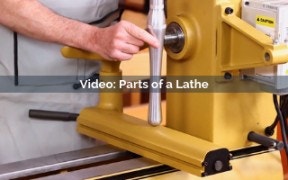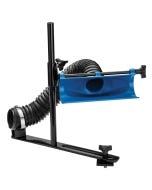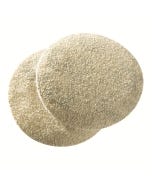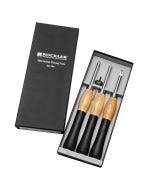Video: Parts of a Lathe

Learn the names and functions of each part of a woodworking lathe. You'll learn the answers to questions about lathes, such as: How is lathe speed controlled? How is the wood supported by the lathe? Is a heavier lathe better than a light weight lathe? What is a lathe banjo? What are the ways?
Skill Builder Video
Parts of a Lathe - Video Transcript
Interviewer: Let's talk about the Lathe a little bit. Specifically starting with the head stock here, what do we want from the muscle of our machine?
Interviewee: Well, of course, it contains the motor which drives this spindle and we want to have a threaded spindle that we can mount chucks on or a morse taper that we can mount chucks in. The most simple lathe has speed control that is just some pulleys where we change a belt. Today, electronics have become very sophisticated and inexpensive, so it's fairly easy to add a variable speed control to lathe. This is usually in combination with a set of pulleys yet and you can liken this speed dial to the accelerator in your car and the pulleys to the gearbox. You're going to use first gear for faceplate turning and second gear for spindle work.
Interviewer: Cool. All right from the head stock let's go to the tail stock here and talk a little bit about the function of the tail stock and the quill.
Interviewee: Well, of course, it is the other end of the support team. It supports the outboard side of the turning, be it faceplate or spindle, because we support both. We want this to be heavy and solid, with a good diameter on the quill and a fair amount of travel here is desirable, because we can drill a deeper hole without moving it, if we put a drill in that tail stock.
Interviewer:That would be handy.
Interviewee: We could reach out over things, so lots of travel is great.
Interviewer: The tail stock moves on these two pieces of cast-iron here. Let's talk a little bit about the ways.
Interviewee: Well, of course, there are two highways that the tail stock and the banjo travel back and forth on and weight is desirable in a lathe. Vibration, which we turners worry about all the time, is directly proportional to the stiffness of the material it's made from. Steel isn't so good because vibration travels along steel well. Cast iron has the quality of soaking up vibration. Also, the more mass in the lathe the better, so having plenty of cast-iron is why we like our grandfather's big old heavy machines.
Interviewer: Let's talk a little bit about the banjo, you mentioned before, and the tool rest.
Interviewee: Well, the banjo, it's important that it move easily and be well-balanced but lock very solid with minimal effort here and also that this tool rest move up and down and back and forth and lock very solidly, with minimal effort. Also, the heighth of the banjo is important. The manufacturers list the swing of their lathe as twice its center heighth, 10 inches in this case, but that's over the bed. The true swing of the lathe is the swing over the banjo. A higher banjo robs from swing.
Interviewer: Great.
Interviewee: Also, of course, this is what we rest the tool on and manipulate it always taking that bevel rubbing.
Interviewer: Right, the bevel. Something I like to think about in tool rest is having different sizes too, so that if you're doing smaller work you can be sure to get the tool rest up close.
Interviewee: I use a six inch a lot for turning boxes and small things like that.
Interviewer: All right. Let's get started turning.
Interviewee: Absolutely.
Keep the inspiration coming!
Subscribe to our newsletter for more woodworking tips and tricks


